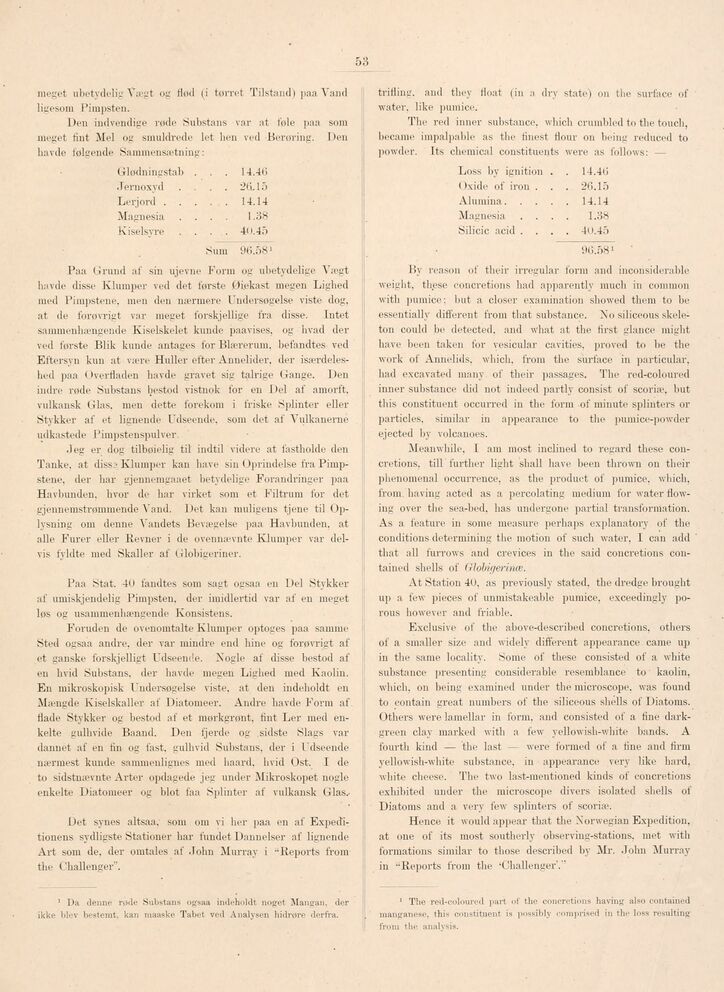
Full resolution (JPEG) - On this page / på denna sida - Sidor ...

<< prev. page << föreg. sida << >> nästa sida >> next page >>
Below is the raw OCR text
from the above scanned image.
Do you see an error? Proofread the page now!
Här nedan syns maskintolkade texten från faksimilbilden ovan.
Ser du något fel? Korrekturläs sidan nu!
This page has never been proofread. / Denna sida har aldrig korrekturlästs.
53
meget ubetydelig Vægt og flod (i tørret Tilstand) paa Vand
ligesom Pimpsten.
Den indvendige røde Substans var at føie paa som
meget fint Mel og smuldrede let hen ved Berøring. Den
havde følgende Sammensætning:
Glødningstab . . . 14.46
Jernoxyd .... 26.15
Lerjord.....14.14
Magnesia .... 1.38
Kiselsyre .... 4» ».45
Sum 96.581
Paa Grund af sin ujevne Form og ubetydelige Vægt
havde disse Klumper ved det første Øiekast megen Lighed
med Piinpstene, men den nærmere Undersøgelse viste dog.
at de forøvrigt var meget forskjellige fra disse. Intet
sammenhængende Kiselskelet kunde paavises, og hvad
delved første Blik kunde antages for Blærerum, befandtes ved
Eftersyn kun at være Huller efter Annelider, der
isærdeles-hed paa ()verfladen havde gravet sig talrige Gange. Den
indre røde Substans bestod vistnok for en Del af amorft,
vulkansk Glas. men dette forekom i friske Splinter eller
Stykker af et lignende Udseende, som det af Vulkanerne
udkastede Pimpstenspulver.
.leg er dog tilbøielig til indtil videre at fastholde den
Tanke, at diss? Klumper kan have sin Oprindelse fra
Piinpstene, der har gjennemgaaet betydelige Forandringer paa
Havbunden, hvor de har virket som et Filtrum for det
gjennemstrømmende Vand. Det kan muligens tjene til
Oplysning om denne Vandets Bevægelse paa Havbunden, at
alle Furer eller Revner i de ovennævnte Klumper var
delvis fyldte med Skaller af Globigeriner.
Paa Ståt. 40 fandtes som sagt ogsaa en Del Stykker
af umiskjendelig Pimpsten, der imidlertid var af en meget
løs og usammenhængende Konsistens.
Foruden de ovenomtalte Klumper optoges paa samme
Sted ogsaa andre, der var mindre end hine og forøvrigt af
et ganske forskjelligt Udseende. Nogle af disse bestod af
en hvid Substans, der havde megen Lighed med Kaolin.
En mikroskopisk Undersøgelse viste, at den indeholdt en
Mængde Kiselskaller af Diatomeer. Andre havde Form af
Hade Stykker og bestod af et mørkgrønt, fint Ler med
enkelte gulhvide Baand. Den ijerde og .sidste Slags var
dannet af en fin og fast. gulhvid Substans, der i Udseende
nærmest kunde sammenlignes med haard, hvid Ost. I de
to sidstnævnte Arter opdagede jeg under Mikroskopet nogle
enkelte Diatomeer og blot faa Splinter af vulkansk Glas.-
Det synes altsaa, som om vi her paa en af
Expeditionen sydligste Stationer har fundet Dannelser af lignende
Art som de. der omtales af John Murray i -’Reports from
the Challenger".
1 Da denne røde Substans ogsaa indeholdt noget Mangan, der
ikke blev bestemt, kan maaske Tabet ved Analysen hidrøre derfra.
trifling, and they float (in a dry state) on the surface of
water, like pumice.
The red inner substance, which crumbled to the touch,
became impalpable as the finest Hour on being reduced to
powder. Its chemical constituents were as follows: —
Loss by ignition . . 14.46
Oxide of iron . . . 26.15
Alumina.....14.14
Magnesia .... 1.38
Silicic acid .... 40.45
90.581 ’
By reason of their irregular form and inconsiderable
weight, these concretions had apparently much in common
with pumice: but a closer examination showed them to be
essentially different from that substance. No siliceous
skeleton could be detected, and what at the first glance might
have been taken for vesicular cavities, proved to be the
work of Annelids, which, from the surface in particular,
had excavated many of their passages. The red-coloured
inner substance did not indeed partly consist of scoriæ, but
this constituent occurred in the form of minute splinters or
particles, similar in appearance to the pumice-powder
ejected by volcanoes.
Meanwhile, I am most inclined to regard these
concretions, till further light shall have been thrown on their
phenomenal occurrence, as the product of pumice, which,
from having acted as a percolating medium for water
flowing over the sea-bed. has undergone partial transformation.
As a feature in some measure perhaps explanatory of the
conditions determining the motion of such water, I can add
that all furrows and crevices in the said concretions
contained shells of (rlobif/erinæ.
At Station 40. as previously stated, the dredge brought
up a few pieces of unmistakeable pumice, exceedingly
porous however and friable.
Exclusive of the above-described concretions, others
of a smaller size and widely different appearance came up
in the same locality. Some of these consisted of a white
substance presenting considerable resemblance to kaolin,
which, on being examined under the microscope, was found
to contain great numbers of the siliceous shells of Diatoms.
Others were lamellar in form, and consisted of a fine
dark-green clay marked with a few yellowish-white bands. A
fourth kind — the last — were formed of a fine and firm
yellowish-white substance, in appearance very like hard,
white cheese. The two last-mentioned kinds of concretions
exhibited under the microscope divers isolated shells of
Diatoms and a very few splinters of scoriæ.
Hence it would appear that the Norwegian Expedition,
at one of its most southerly observing-stations, met with
formations similar to those described by Mr. John Murray
in "Reports from the ’Challenger’."
1 The red-coloured part of the concretions having also contained
manganese, this constituent is possibly comprised in the loss resulting
from the analysis.
<< prev. page << föreg. sida << >> nästa sida >> next page >>